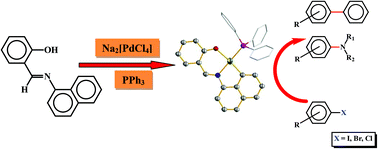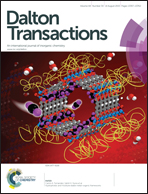Palladium(0)-mediated C–H bond activation of N-(naphthyl)salicylaldimine and related ligands: utilization of the resulting organopalladium complexes in catalytic C–C and C–N coupling reactions†
Abstract
N-(Naphthyl)-4-R-salicylaldimines (R = OCH3, H and Cl; H2L1–H2L3) and 2-hydroxy-N-(naphthyl)naphthaldimine (H2L4) readily undergo, upon reaction with Na2[PdCl4] in the presence of triphenylphosphine, cyclopalladation via C–H bond activation at the peri-position to afford complexes of type [Pd(L)(PPh3)] (L = L1–L4). The C–H bond activation has been found to be mediated by palladium(0) formed in situ. A similar reaction of H2L1 with Na2[PdCl4] in the presence of 1,2-bis(diphenylphosphino)ethane (dppe), in a 2 : 2 : 1 mole ratio, yields a dinuclear complex of type [{Pd(L1)}2(dppe)]. Reaction of H2L1 with Na2[PdCl4] in the presence of 4-picoline (pic) yields [Pd(L1)(pic)]. The molecular structures of the six complexes have been determined by X-ray crystallography. The aldiminate ligand in each compound is coordinated to the metal center as a di-anionic tridentate ONC-donor, with the fourth coordination site occupied by a phosphine or picoline ligand. The new complexes show intense absorptions in the visible and ultraviolet regions, and the nature of the optical transitions has been analyzed by TDDFT calculations. The palladium complexes display notable efficiency in catalyzing C–C and C–N bond coupling reactions. The thermodynamics for the formation of the cyclometalated catalyst precursor [Pd(L2)(PPh3)] has been evaluated by DFT calculations.


 Please wait while we load your content...
Please wait while we load your content...